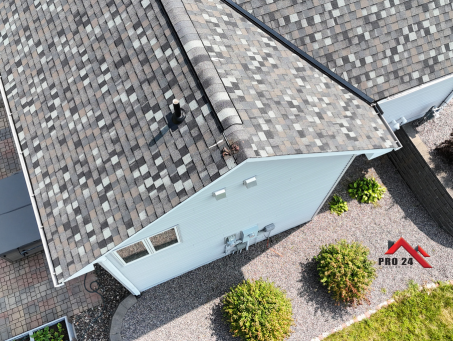When choosing the best roofing material for your home, the variety of options can feel overwhelming. Each type offers unique benefits, from the rustic charm of wood shingles to the industrial durability of metal roofing. However, one material consistently stands out as a practical, versatile, and cost-effective solution: the composition roof.
Known for its balance of durability, affordability, and style, a composition roof has become a preferred option for homeowners seeking reliable protection and curb appeal without overspending.
Our Composition Roof Guide
Modern advancements in roofing technology have further enhanced the appeal of composition roofs, making them more stylish and customizable than ever. They can replicate premium materials like slate or wood, delivering luxurious aesthetics at a fraction of the price.
Whether you’re preparing to upgrade your current roof or choosing the ideal materials for a brand-new construction project, gaining a clear understanding of the advantages, expenses, and upkeep requirements of a composition roof is essential.
This knowledge empowers you to make an informed, confident decision that aligns with your home’s needs, your aesthetic preferences, and your long-term budget.
In this detailed and thoroughly researched guide, we’ll walk you through everything there is to know about composition roofs. From understanding their unique construction and the benefits they offer to practical maintenance tips and an in-depth cost comparison, we’ve got you covered.
What Is a Composition Roof?
A composition roof is a robust and versatile roofing solution crafted from a combination of materials, including asphalt, fiberglass, and recycled elements. These components are skillfully layered to form a resilient, weatherproof barrier designed to endure a wide range of environmental conditions with reliability and strength.
The name “composition” refers to the combination of materials working in harmony to deliver superior performance. Unlike single-material roofs such as wood or slate, a composition roof is engineered for enhanced strength, increased resistance to wear and tear, and an extended lifespan.
This multi-material construction allows composition roofs to thrive in various climates and architectural styles. Whether you live in an area prone to heavy rain, snow, or intense sun, a composition roof offers a practical yet visually appealing solution.
Different kinds of Composition Shingles
Composition roofs come in three main types of shingles, each suited to different budgets and aesthetic preferences:
-
3-Tab Shingles
-
-
- The most budget-friendly choice, offering a flat, uniform appearance.
- Ideal for homeowners on a budget or with simpler roofing needs.
-
-
Architectural Shingles
-
-
- Also called laminate shingles, these offer a thicker, dimensional look.
- Provide enhanced durability and improved curb appeal.
-
-
Premium Shingles
-
- Replicate the look of premium materials such as slate or cedar.
- Deliver superior aesthetics and long-lasting performance.
Each type offers unique advantages, allowing homeowners to select the option that best meets their needs and design preferences.
Benefits of a Composition Roof
- Affordable and High-Performing
Composition roofs provide outstanding value. They cost significantly less than materials like slate or metal while still delivering excellent performance. With proper care, they last 20–30 years, making them a smart investment for budget-conscious homeowners. - Built for Tough Conditions
Engineered to withstand diverse weather conditions, composition shingles can endure heavy rain, hailstorms, and high winds. Many modern options include UV protection, algae resistance, and impact ratings to ensure long-term durability. - Minimal Maintenance Needs
Keeping your composition roof in great shape is straightforward. Simple tasks like cleaning gutters and promptly removing organic debris—such as fallen leaves or twigs—prevent moisture buildup and extend the roof’s lifespan. Unlike wood shingles, composition roofs resist rotting and warping, further reducing maintenance demands. - Extensive Design Options
With a vast array of colors, textures, and styles, composition roofs can match any architectural style. Whether you prefer a sleek, modern look or something more traditional, there’s a composition shingle to suit your tastes. Premium options even replicate the elegance of slate or wood, offering luxurious curb appeal without the high cost. - Eco-Friendly Features
Many composition shingles are made from recycled materials, making them an environmentally conscious choice. Additionally, some options are designed to reflect solar heat, reducing energy costs by keeping your home cooler during the summer. - Quick and Efficient Installation
Composition roofs are relatively easy to install, which reduces labor costs and minimizes disruption to your daily life during the installation process.
Composition Roof Costs
The price of a composition roof is influenced by various factors, such as the type of shingles chosen, the size of the roof, and any additional features or upgrades. Let’s delve into the key elements that affect the overall cost:
Key Factors Affecting Costs
- Type of Shingles:
3-tab shingles are the most affordable, while architectural and premium shingles cost more due to their enhanced durability and visual appeal. - Roof Size:
A larger roof demands more materials and labor, which drives up the overall cost. - Roof Complexity:
Steeper slopes or intricate designs take longer to install, raising labor costs. - Additional Features:
Items like underlayment, ridge caps, flashing, and ventilation systems add to the overall expense.
Average Costs
For a standard residential roof, composition roofing costs range from $5,000 to $12,000. High-end designs that replicate slate or cedar can exceed $15,000. While the initial investment may seem significant, the durability and low maintenance requirements of composition roofs make them a cost-effective choice over time.
Comparing Composition Roofs to Other Materials
To fully appreciate the value of a composition roof, it helps to compare it to other common roofing materials:
- Metal Roofing:
Extremely durable and long-lasting but significantly more expensive. - Tile Roofing:
Offers a distinctive aesthetic but is heavy, costly, and requires specialized installation. - Wood Shingles:
While visually appealing, wood shingles are less durable and demand frequent maintenance. - Slate Roofing:
Known for luxury and durability, slate is one of the most expensive materials and requires reinforced structures to support its weight.
When considering cost, durability, and aesthetics, composition roofs often strike the best balance for homeowners.
Tips for Prolonging Your Roof’s Lifespan
A composition roof can last decades with proper care. Here are some essential maintenance tips:
- Schedule Annual Inspections
Schedule regular inspections with a professional roofer at least once a year and after significant storms. This proactive approach helps identify and resolve potential issues before they escalate into costly problems. - Clean Gutters and Downspouts
Ensure gutters remain clear to prevent water pooling, which can damage the roof over time. - Remove Debris Promptly
Clearing leaves and other debris from your roof prevents moisture retention, which can encourage mold or algae growth. - Trim Nearby Trees
Overhanging branches can scrape against shingles during storms, causing unnecessary wear and tear. - Address Repairs Quickly
Fixing missing shingles, cracks, or leaks promptly prevents more significant damage.
By following these simple steps, you can extend your roof’s lifespan and avoid costly repairs or premature replacement.
Signs It’s Time to Replace Your Composition Roof
Even the most durable roofs have a lifespan. Here are some signs that it may be time for a replacement:
- Curling, cracking, or missing shingles.
- Excessive granule loss, visible in gutters or on the ground.
- Water damage or leaks inside your home.
- Roof age exceeding 20–30 years.
If you notice these issues, consult a professional roofing contractor. They can help you determine whether repairs or a full replacement is the best solution.
Choosing the Right Roofing Contractor
The quality of your roof depends on the materials used and the expertise of the contractor. When selecting a professional roofer, consider the following:
- Experience. Choose a contractor with a proven track record of installing composition roofs.
- Licensing and Insurance. Verify that the contractor is licensed and carries appropriate insurance.
- Reputation. Read reviews and ask for references from previous customers.
- Detailed Estimates. Request written estimates from multiple contractors to compare pricing and services.
Hiring a qualified contractor ensures your roof is installed correctly and will stand the test of time.
Final Thoughts
A composition roof is the perfect blend of durability, affordability, and aesthetic appeal. With its wide range of styles, eco-friendly features, and minimal maintenance requirements, it’s no surprise that this roofing material is a favorite among homeowners.
By gaining a clear understanding of the costs, advantages, and maintenance requirements of a composition roof, you’ll be equipped to make a well-informed choice that enhances both the value and protection of your home.
Whether you’re upgrading an aging roof or selecting the perfect material for a new construction project, a composition roof delivers an exceptional blend of practicality, durability, and aesthetic appeal. Its combination of functionality and timeless style makes it a top contender for homeowners seeking a roofing solution that stands the test of time.
Pro 24 Contracting is here to help you with all your roofing needs. Our team specializes in high-quality composition roof installations tailored to your specific requirements. Contact us today to schedule a consultation and take the first step toward a durable, beautiful roof that enhances your home’s curb appeal and protects it for years to come!

